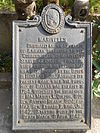| Marker title | English Translation | Category | Type | Description | Location | Language | Date Issued | Image |
|---|
| Artillery Memorial | | Structure | Memorial | Housed the Philippine Army Artillery Training Center. Formerly Camp Dau, became Camp del Pilar. | Dau, Mabalacat City | Filipino | March 10, 1996 | |
| Artillery Memorial [19] | | | | Housed the Philippine Army Artillery Training Center. Formerly Camp Dau, became Camp del Pilar. | Mabalacat City | Filipino | May 11, 2017 |  |
| Augusto P. Hizon House | | | | Declared as a heritage house by the NHCP. | Augusto Hizon Ancestral House, Consunji St., San Fernando City | English | 2010 |  |
| Aurelio V. Tolentino | | | | Playwright and novelist. Writer in Spanish, Tagalog, and Pampango. | Guagua | Filipino | October 13, 1987 | |
| Aurelio Tolentino | | | | Revolutionary, playwright, novelist, and poet. One of those who signed the Declaration of Philippine Independence. | Tolentino Monument, Municipal Plaza, Sen. Gil Puyat Ave., Guagua | Filipino | October 13, 2017 |  |
Bacolor
(1576–1976) | | | | Founded by Augustine Friars in 1576 under the patronage of William the Hermit. Headquarters of Simon de Anda during the British invasion. | Bacolor | Filipino | February 10, 1976 | |
| Ang Bahay na Sinilangan ni Pangulong Diosdado Macapagal | House where President Diosdado Macapagal was Born | Building | House | In this simple house was the place where the Fifth President of the Philippines was born. | President Diosdado P. Macapagal Library and Museum, Lubao Old National Road, Barrio San Nicolas, Lubao | Filipino | 1952; February 20, 1990 |  |
| Bahay ni Angel Pantaleon de Miranda | House of Angel Pantaleon de Miranda | | | Became a place of refuge for Aguinaldo's forces during the Filipino-American War | 290 Calle Sto. Rosario, Angeles City | Filipino | December 7, 1986 |  |
| Barasoain Church Replica [20] | | | | | Expo Filipino, Clark, Mabalacat City | | | |
Benigno S. Aquino Jr.
"Ninoy"
(1923–1983) | | | | Tarlac governor who became senator. A political opponent of Ferdinand Marcos. | Pampanga Provincial Capitol grounds, San Fernando City | Filipino | 2009 |  |
| Bienvenido M. Gonzalez (1893–1953) | | | | Distinguished scientist and the sixth president of the University of the Philippines. | Apalit | Filipino | December 30, 1982 |  |
| Church of Apalit | | Building | House of Worship | The church dates back to 1590. Former church of brick destroyed by the earthquake of 1863. | Apalit Church façade, Apalit | English | 1939 |  |
| Church of Lubao | | Building | House of Worship | Architect Fr. Antonio Herrera, Augustinian, constructed this church, 1614–1630. | Lubao Church façade, Lubao | English | 1952 |  |
| Church of Magalang | | | | Established by the Augustinians in 1605. Occupied by the Japanese on January 3, 1942. | Magalang | English | | |
Clark Field
(Fort Stotsenburg) | | Structure | Military Camp | Formerly a pati or Aeta community.Historical military camp established by the Americans. | Clark Field, Angeles | Filipino | September 1, 2003 |  |
| Dayrit House | | | | Declared as a heritage house by the NHCP. | Dayrit-Cuyugan Ancestral House, MacArthur Highway, San Fernando City | English | January 8, 2004 |  |
Death March
April 1942 | | Site | Site | One of the ghastliest forced marches in history. Site of the railroad station where Filipino and American forces were inhumanely loaded. | San Fernando Railroad Station, San Fernando City. | Filipino and English | 1956 |  |
| Death Place of Roxas | | Site | Site | Manuel Roxas, first President of the Republic of the Philippines, died here on April 15, 1948. | Clark Field, Angeles City | English | 1955 | 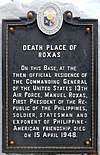 |
Diosdado Macapagal
(1910–1997) | | | | Ninth president of the Philippines, native of Lubao, Pampanga. Shifted independence date from July 4 to June 12. | Pampanga Provincial Capitol, San Fernando City | Filipino | 2009 |  |
Diosdado Macapagal
(1910–1997) | | | | Ninth president of the Philippines. Known as the "poor boy from Lubao." | Arayat Central Elementary School, Arayat, Pampanga | English | 2001 | |
| Diosdado P. Macapagal | | | | Ninth president of the Philippines. Was helped by the philanthropist Honorio Ventura. | President Diosdado P. Macapagal Library and Museum, Lubao Old National Road, Barrio San Nicolas, Lubao | English | 1990 |  |
| Diosdado P. Macapagal | | | | Ninth president of the Philippines. Known as the "poor boy from Lubao." | Macapagal Monument, Lubao Central Elementary School, Purok 1–2 San Nicolas 1st Rd., Barrio San Nicolas, Lubao | English | 2001 |  |
| Don Honorio Ventura Technological State University [21] | | | | First established as Colegio de Instruccion Primaria y Latinidad by Father Juan Zita and Felino Gil on November 4, 1861. | Don Honorio Ventura Technological State University, MacArthur Highway, Bacolor | Filipino | 2014 |  |
| Emilio Aguilar Cruz (1915–1991) | | | | Writer, editor, statesman, diplomat, and artist. Born on June 5, 1915. | Emilio Aguilar Cruz (EAC) Museum, Abe's Farm, Magalang (original location: Magalang Town Plaza, Magalang) | Filipino | August 7, 1992; reunveiled on November 12, 2015 [22] |  |
| Felipe Sonsong (1611–1686) | | | | Became part of Maniago revolt and was exiled to the Marianas until his death. | Macabebe | Filipino | May 1, 2011 |  |
| Felix Galura 1866–1919 | | | | Revolutionary and great Kapampangan writer. Headed the siege of Bacolor, to free the province from the Spaniards. | Felix Galura Monument, Don Honorio Ventura St., Bacolor | Filipino | October 5, 2017 |  |
| Guagua National Colleges | | | | First established on June 18, 1918, by Father Nicanor Banzali within the old convent of Guagua Church. | Guagua National Colleges, Sta. Filomena Rd., Guagua | Filipino | February 24, 1993 |  |
| Henson-Hizon House | | | | Declared as a heritage house by the NHCP. | Henson-Hizon Ancestral House, V. Tiomico St., San Fernando City | English | October 25, 2003 |  |
| Hizon-Singian House | | | | Declared as a heritage house by the NHCP. | Hizon-Singian Ancestral House, Consunji St., San Fernando City | English | 2003 |  |
Honorio Ventura
(1887–1940) | | | | Philanthropist and public servant, who became governor of Palawan from 1914 to 1921. | Pampanga Capitol Grounds, San Fernando City | Filipino | 2009 |  |
| Joaquin Gonzalez | | | | Became representative of Pampanga for the revolutionary congress. | Apalit | Filipino | July 1982 | |
José Abad Santos
(1886–1942) | | | | Statesman who was martyred during World War II as he declined allegiance to the Japanese forces. | San Fernando City | English | | |
José Abad Santos
(1886–1942) | | | | Statesman who was martyred during World War II as he declined allegiance to the Japanese forces. | José Abad Santos Monument, Gov. Macario Arnedo Park, Provincial Capitol Grounds, San Fernando City | Filipino | 2009 |  |
José Abad Santos
(1886–1942) | | | | Statesman who was martyred during World War II as he declined allegiance to the Japanese forces. | Heroes Hall, Lazatin Blvd., San Fernando City (currently within NHCP storage) | Filipino | 2004 |  |
José Abad Santos
1886 – 1942 | | | | Statesman who was martyred during World War II as he declined allegiance to the Japanese forces. | Heroes Hall, Lazatin Blvd., San Fernando City | Filipino | 2017 |  |
| Jose B. Lingad 1914 – 1980 | | | | Guerilla leader during WWII, assassinated during the Marcos dictatorship. | Jose B. Lingad Park and Museum, Lubao | Filipino | November 24, 2021 [23] |  |
| Juan Crisostomo Soto (Crissot) (1867–1918) | | | | Distinguished Pampango poet, dramatist, and newspaperman. Translated into Kapampangan Noli me Tangere and El Filibusterismo. Joined the Philippine Revolution and the Filipino-American War. | Soto Monument, MacArthur Highway, Bacolor | English | 1961, 2012 |  |
| Himpilang Daang-bakal ng San Fernando | San Fernando Railroad Station | Structure | Train Station | Built in 1892 as part of the Manila-Dagupan railroad line. Site where Filipino and American forces were loaded after the death march. | San Fernando Railroad Station, San Fernando City | Filipino | April 9, 2004 |  |
| Ang Kabataang Pinuno ng Macabebe [24] | The Young Warrior of Macabebe | | Monument | In honor of the Brave Youth of Macabebe, who died in the Battle of Bangkusay Channel on June 3, 1571. | Tarik Monument, Macabebe Municipal Building, Macabebe | Filipino | June 3, 2016 | 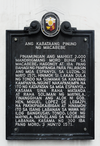 |
| Katedral ng San Fernando | San Fernando Cathedral | Buildings/ Structures | House of Worship | First established by the Augustinians in 1755. | San Fernando Cathedral, San Fernando City | Filipino | August 15, 2023 |  |
| Labanan sa Macabebe [25] | Battle of Macabebe | | Site of an Important Event | Gen. Isidoro Torres attacked the Spaniards on June 25, 1898. The artillery was seized three days after. | Macabebe | Filipino | June 25, 2013 |  |
| Luis Taruc [26] | | Personage | Monument | Patriot and defender of the rights of farmers and workers, founder of Hukbalahap | Luis Taruc Freedom Park, San Luis, Pampanga | Filipino | June 21, 2017 | |
| Lalawigan ng Pampanga | Province of Pampanga | | | Explored by Augustinian priests in 1571. Became a very progressive province during the Spanish regime. | Pampanga Provincial Capitol, San Fernando City | Filipino | December 11, 1982 |  |
| Lazatin House | | | | Declared as a heritage house by the NHCP. | Lazatin Ancestral House, Consunji St., San Fernando City | English | October 25, 2003 |  |
| Magalang | | | | Town established in 1605. Site of the 1660 battle between the forces of Andres Malong under the command of Melchore De Vera and Spanish troops. | Magalang Public Plaza, Magalang | English | 1954 |  |
| Mansyong Pamintuan | Pamintuan Mansion | | | In June 1899, became temporary headquarters of Emilio Aguinaldo while Tarlac was being set up as the capital of the republic. | Pamintuan Ancestral House, Miranda St., cor Sto. Entiero St., Angeles City | Filipino | August 17, 2017 | 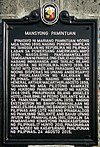 |
| Ang Mansyon ng mga Pamintuan | The Pamintuan Mansion | Building | NHCP Museum | Became the headquarters of the revolutionary army and Emilio Aguinaldo. | Pamintuan Ancestral House, Miranda St., Angeles City | Filipino, English | 2002 | 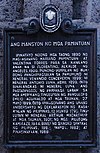  |
| Matandang Tahanan ng mga Lacson | Lacson Ancestral House | | | Built in 1923. A house characterized by genuine Kapampangan artistic expression and skill. | Magalang | Filipino | June 21, 1995 | |
Maximino H. Hizon
(1870–1901) | | | | General of the Philippine Revolution and the Filipino-American War. Exiled by the Americans to Guam. | Pampanga Provincial Capitol, San Fernando City | Filipino | September 1, 2001 | 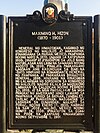 |
| Monico R. Mercado | | | | Co-sponsored the bill instituting the first irrigation systems in the Philippines. | Sasmuan | English | 1966 | |
| Nicolasa Dayrit-Panilio | | | | Joined the revolutionary forces and helped the sickly and wounded during the Filipino-American War. | Henson-Hizon House, V. Tiomico St., San Fernando | Filipino | September 10, 2006 |  |
| Paciano Dizon y Santos | | | | Hailed by the US president as the first Filipino Deputy Insular Auditor. | Porac | Filipino | June 30, 1982 |  |
| Pampanga High School | | | | Opened in 1908 in what is now Pampanga Hotel. Where Diosdado Macapagal finished secondary schooling in 1929. | Pampanga High School, High School, Blvd., San Fernando (currently within NHCP storage) | Filipino | 2010 |  |
| Pampanga High School | | | | Established in San Fernando in 1902. First batch of students finished in 1912. | Pampanga High School, High School, Blvd., San Fernando | Filipino | August 14, 2018 [27] |  |
| Pampanga Provincial Jail | | | | Designed by William E. Parsons in 1909. An example of provincial architecture during the American occupation. | Pampanga Provincial Jail, Sta. Lucia Sto. Niño Viejo Rd., Capitol grounds, San Fernando | Filipino | 2009 | 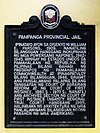 |
| Pampanga School of Arts and Trades (Formerly Escuale de Artes y Oficios de Bacolor) | | | | Founded in 1861. Became the capitol site of Pampanga from 1901 to 1904. | Don Honorio Ventura Technological State University, MacArthur Highway, Bacolor | English | 1962 (buried by Lahar) | |
| Pedro Abad Santos 1876–1945 [28] | | | | Founded the Socialist Party of the Philippines in 1932 and became the vice president of the 1930 Communist Party of the Philippines from 1938 to 1942. | Heroes Hall, Lazatin Blvd., San Fernando City | Filipino | 2010 |  |
| Pisamban Maragul (Pisamban ning Angeles) | The Large Church (Church of Angeles) | | | Formerly a visita of San Fernando, the first chapel was built in 1812. | Angeles City | Kapampangan, Filipino | August 17, 2017 |   |
| Renato D. Tayag | | | | Author, lawyer, soldier, and sportsman. Fought in Bataan and was part of the death march. | Angeles Library and Information Center, Sto. Entiero St., Angeles City | Filipino | October 9, 1986 |  |
| Rufino J. Cardinal Santos (1908–1973) | | | | First Filipino cardinal. Founded Caritas Manila in 1953. Headed the reconstruction of Manila Cathedral from 1956 to 1958. | Rufino Cardinal Santos Catholic Center, Guagua | Filipino | 2008 |  |
| Santa Iglesia | | | | Religious fraternity established in Apalit that launched armed revolts against Spanish and American colonizers. | San Fernando City Hall, San Fernando City Pampanga | Filipino | December 10, 2023 [29] | 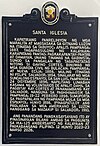 |
| San Fernando Landas ng Pagkabansang Pilipino, 1899 | | Sites/ Events | Site | Where the Revolutionary government stayed en route from Malolos to San Isidro. | Gen. Hizon Extension | Filipino | April 1, 2024 |  |
| Ang Simbahan ng Santa Ana [30] | The Church of Santa Ana | | | Established by the Augustinians as a visita of Arayat on December 19, 1598.Became a garrison and torture place during World War II | Santa Ana Church façade, Santa Ana | Filipino | October 22, 2013 |  |
| Simbahan ng Guagua | Guagua Church | | | Church established by Augustinian priests in 1590. Stone church was built in 1661 under Father Jose Duque. | Guagua Church façade, Guagua | Filipino | October 13, 1982 | 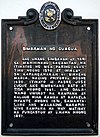 |
| Simbahan ng Macabebe | Macabebe Church | | | Established by Augustinian priests in 1575, same year with the townhood. Became the headquarters of Comandancia General del Centro y Norte of the Spanish troops on June 16, 1898. | Macabebe | Filipino | September 10, 2018 |  |
| Tiburcio Hilario (1853–1903) | | | | Appointed by Emilio Aguinaldo as governor of Pampanga, June 1898 and as the representative of Iloilo to the Malolos Congress, September 15, 1898. | Heroes Hall, Lazatin Blvd., San Fernando City | Filipino | 2009 |  |
| Unang Pamahalaang Sibil | First Civil Government | | | Where the Commission of the Philippines under William Howard Taft established the first civil government in Pampanga, now celebrated as "Pampanga Day" on its anniversary on February 13. | Bacolor | Filipino | February 13, 1978 | |
| Vicente S. Manansala (1910–1981) | | | | Distinguished painter and muralist. Awarded as a national artist posthumously. | Macabebe Town Hall, Macabebe | Filipino | August 22, 1985 |  |
| Vicente S. Manansala (1910–1981) | | Building | House | Famous painter and muralist. Awarded as a National Artist in 1981. | Holy Angel University, Angeles City (original location: Manansala House, Binangonan, Rizal) | Filipino | January 22, 1984 | |
| Vivencio B. Cuyugan, Sr. [31] | | Structure | Monument | First socialist mayor of the Philippines. One of the founders of Hukbalahap. | Cuyugan Ancestral House, Vivencio Cuyugan Rd., Brgy. del Pilar, San Fernando, Pampanga | Filipino | March 14, 2017 |  |
Zoilo J. Hilario y Sangalang
(1892–1963) | | | | Poet and jurist. Poet laureate in the Spanish and Kapampangan languages. | Pampanga Provincial Capitol, San Fernando City | Filipino | June 27, 1982 |  |




















